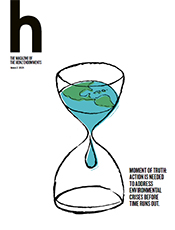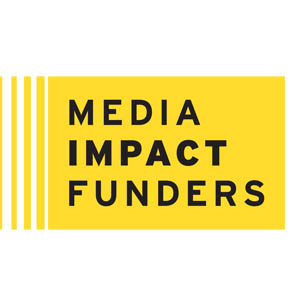
There’s a foreboding sketch of an hour glass with an image of a melting globe dripping through it on the most recent edition of h magazine, the semi-annual publication produced by The Heinz Endowments. The headline on the cover declares, “Moment of Truth: Action is Needed to Address Environmental Crises Before Time Runs Out.”
 The magazine brings together a powerful case for environmental action, with many stories drawn from the insight, expertise and experience of Heinz grantees, including scientists, activists and journalists. As Heinz President Grant Oliphant says in the opening essay, “We are devoting time and energy to telling stories that elevate the potential of a more sustainable future with opportunities for a clean, innovative and effective economy, and that focus on promoting healthier human lives and communities.”
The magazine brings together a powerful case for environmental action, with many stories drawn from the insight, expertise and experience of Heinz grantees, including scientists, activists and journalists. As Heinz President Grant Oliphant says in the opening essay, “We are devoting time and energy to telling stories that elevate the potential of a more sustainable future with opportunities for a clean, innovative and effective economy, and that focus on promoting healthier human lives and communities.”
This special edition of the magazine is also, in itself, an excellent example of the compelling work in media and communications that has become the hallmark of The Heinz Endowments. In addition to the magazine, Heinz also publishes a vibrant blog and a professionally produced podcast series in which Grant engages in thoughtful dialogue with Heinz grantees and other experts, including recent episodes with Environmental Health News investigative reporter Kristina Marusic and Pennsylvania State University professor and climate change expert Michael Mann, author of The New Climate War.
Altogether, the regional foundation carries out a robust communications strategy, led by vice president of communications, John Ellis. In addition to telling its own stories effectively, the foundation increasingly has devoted substantial grant resources to support media and journalism activities in Southwest Pennsylvania and focusing on areas of great program interest to the Endowments.
Changing Leadership at the Endowments
Grant recently announced his impending departure from Heinz to take a new role as chief executive officer of the San Diego-based Conrad Prebys Foundation, beginning in March. And with Vice President of Creativity Janet Sarbaugh—the foundation’s longest-serving employee—also stepping down this year, it feels like the right time to take stock of the journalism and media initiatives that Heinz has supported in recent years.
Over the years, Grant told us recently, journalism has become more and more central to the foundation’s programmatic priorities as the importance of advancing public awareness came into clearer view. In 2017, to better understand the information needs of the Pittsburgh region, The Heinz Endowments and the Hillman Family Foundations supported a media landscape assessment conducted by Media Impact Funders. This process examined the current dynamics among western Pennsylvania’s media outlets, and the challenges and potential for providing the kind of explanatory and investigative journalism that Pittsburgh’s communities needed. The analysis laid the groundwork for Heinz and other supporters of journalism to continue building the local news ecosystem and also to the creation of the Pittsburgh Media Partnership.
Around the same time, Grant wrote a blog post defending the arts and journalism, asserting its role in protecting democracy and free expression. “Art and journalism are … just as the framers of our Constitution intended, beautiful catastrophes of disruption,” Grant wrote. “They ask the questions others don’t dare to; they shine light where truth hides; they root out the lies and phony masks we hide behind; they dare us to look beyond our narrow lives and convictions.”
Since then, The Heinz Endowments’ media strategy has taken on a three-pronged approach, focusing on general media ecosystem work, niche journalism and racial equity. Here’s a quick look at some of Heinz’s work in these areas over the years:
General/Ecosystem Support
- Helped buy out a local public radio station to save it and convert it to an all-news format, which is now WESA-FM.
- Helped to establish a nonprofit journalism outlet called PublicSource to do explanatory journalism and pursue deeper narratives in the community.
- Provide major funding to Spotlight PA, an investigative journalism outlet, in concert with more traditional media in Pennsylvania to raise the visibility of key policy-making and decision-making in the state.
- Major funder of the Pittsburgh Media Partnership, which is working to build the region’s public-interest media through a collaboration of various media outlets to co-design solutions and generate shared knowledge for the challenges ahead.
Topic-Based Journalism
- Funded the Warhorse, which supports journalism in the veterans space—a major priority for the foundation. This support has proved highly effective for informing public dialogue about veterans issues.
- To address environmental issues—critically important in the Pittsburgh region—funded reporting from the Environmental Health Network and for an environmental program called Allegheny Front.
Racial Equity
- To support racial equity, invested more in Black media across communities in Pittsburgh, the birthplace of one of the country’s most influential early Black newspapers, The New Pittsburgh Courier.
- Major funder, through the foundation’s cultural giving, of 1Hood Media, which trains young people on telling their stories.
- Launched BlackPittsburgh.com (brainchild of 1Hood Media)
Grant acknowledged that this work isn’t without challenges. For example, measuring impact is an ongoing conversation. Another is sustainability. How public media continues to evolve in Pittsburgh so that it isn’t 100 percent reliant for the lion’s share of its resources on philanthropy is a question that Pittsburgh funders—the region has several strong players in media philanthropy—are looking at, Grant told us.
At the same time, Pittsburgh has a “tremendous thirst” for quality information flows, and The Heinz Endowments is well aware of the importance of that information.
Grant understands the concern some funders may have when the media they support may sometimes produce results that are uncomfortable. “I think it’s important to acknowledge that we wrestle hard with the question of what we do when media you support do things that you would not have done.”
“We are going to fund people who do uncomfortable things,” he says. “Finding the sweet spot where that is OK and sustainable for foundations is an issue that our field maybe needs to look at more.”
